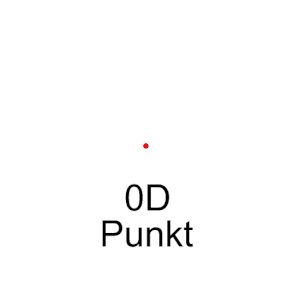Hypercube
![]()
This article is about the dimensional polytope hypercube; for the communication pattern, see hypercube (communication pattern).
Hypercubes or dimensional polytopes are 




Projection of a tesseract (four-dimensional hypercube) into the 2nd dimension
Regular cube construction
Regular cubes of edge length 

- If a point is
moved in a straight line by the distance a , the result is a one-dimensional line, mathematically a one-dimensional hypercube.
- If this distance is
shifted perpendicular to its dimension by the distance , the result is a two-dimensional square, a surface, mathematically a two-dimensional hypercube.
- If this square is
shifted perpendicular to its two dimensions by the distance , the result is a three-dimensional cube, mathematically equivalent to a three-dimensional hypercube.
- General: Thus, if an
-dimensional cube is
shifted perpendicular to its dimensions
by distance , a
-dimensional hypercube is formed.
Boundary Elements
In a hypercube of dimension 

The 

The 3-dimensional cube is bounded by nodes (points), edges (lines) and faces, i.e. by elements of the dimensions 0,1 and 2.
The number of individual boundary elements can be derived from the following consideration: Let be 









Example
- The 2-dimensional hypercube is bounded by 1 face
, 4 edges
and 4 nodes
.
- The 3-dimensional cube is bounded by
faces
, bounded by
edges
and
Nodes
.
Another way to think about it is: If one places an 










|
| Schläfli symbol | Number of boundary elements | ||||||||||||||
| 0-dim. | 1-dim. | 2-dim. | 3-dim. | 4-dim. | |
|
| |||||||||
| Item | | 1 | ||||||||||||||
| Route | | 2 | 1 | |||||||||||||
| Square | | 4 | 4 | 1 | ||||||||||||
| 3-dim. cube | | 8 | 12 | 6 | 1 | |||||||||||
| 4-dim. cube | | 16 | 32 | 24 | 8 | 1 | ||||||||||
| | ||||||||||||||||
|
| | | | | | | | | | |||||||
Each 










The way to the hypercube

The 0- to 5-dimensional cubes in parallel projection
Questions and Answers
Q: What is a hypercube?
A: A hypercube is an n-dimensional analogue of a square (n = 2) and a cube (n = 3). It is a closed, compact, convex figure whose 1-skeleton consists of groups of opposite parallel line segments aligned in each of the space's dimensions, perpendicular to each other and of the same length.
Q: What is the longest diagonal in an n-dimensional hypercube?
A: The longest diagonal in an n-dimensional hypercube is equal to n {\displaystyle {\sqrt {n}}}.
Q: Is there another term for an n-dimensional hypercube?
A: An n-dimensional hypercube is also called an n-cube or an n-dimensional cube. The term "measure polytope" was also used but it has now been superseded.
Q: What does "unit hypercube" mean?
A: A unit hypercube is a hypercube whose side has length one unit. Often, the unit hypercube refers to the specific case where all corners have coordinates equal to 0 or 1.
Q: How can we define a "hyperrectangle"?
A: A hyperrectangle (also called an n-orthotope) is defined as the general case of a hypercube.
Search within the encyclopedia













